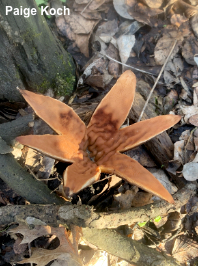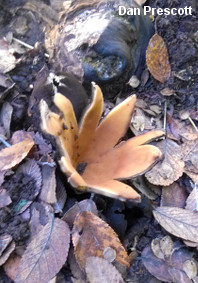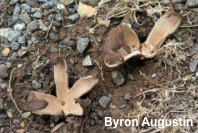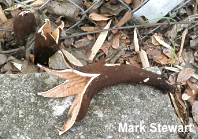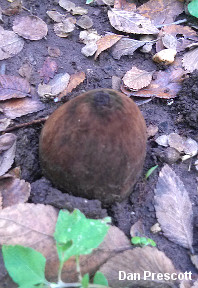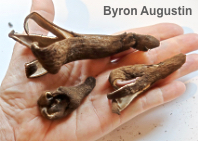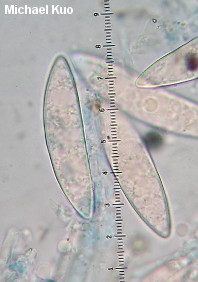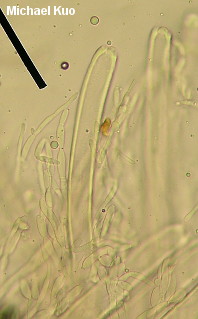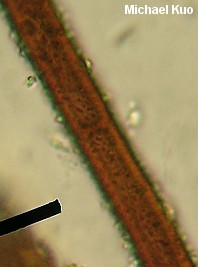| Major Groups > Cup Fungi > Chorioactis geaster |

|
Chorioactis geaster [ Ascomycota > Pezizales > Chorioactidaceae > Chorioactis ... ] by Michael Kuo How cool is this thing? Like a cross between a cup fungus and an earthstar, Chorioactis geaster is found only in a few Texas counties and one prefecture in Japan. Texas collections like the one illustrated here are usually associated with decaying cedar elm stumps. At first, this mushroom looks like a tiny, fuzzy American football—but it soon begins to expand and peel back into star-like rays, as the color of the upper surface progresses from whitish to brownish orange to, finally, dull yellow. Under the microscope, Chorioactis geaster is truly fascinating. Its spores are enormous and shaped like stretched-out footballs; its paraphyses are multi-septate, and they develop swollen, chained-together cells; its asci are thick-walled and funky; and the hairs on its outer surface are double-walled and minutely prickly. A DNA study of Texas and Japanese collections of Chorioactis geaster by Peterson and collaborators (2004) determined that the North American and Asian specimens were phylogenetically distinct, and appear to have separated into two lineages about 19 million years ago. Another recent phylogenetic study (Pfister, Slater & Hansen, 2008) placed Chorioactis geaster—along with Wolfina aurantiopsis and a few other rare mushrooms—in a new family, the Chorioactidaceae. The mushrooms share some similar micro-morphological features, including cyanophilic spores and warty to spiny hairs on the outer surface. Urnula geaster is a previous name. Thanks to Dan Prescott, Byron Augustin, Jeff and Paige Koch, and Mark Stewart for collecting, documenting, and preserving Chorioactis geaster for study; their collections are deposited in The Herbarium of Michael Kuo. Description: Ecology: Apparently saprobic on the decaying wood of cedar elm (Ulmus crassifolia); growing scattered to gregariously on or very near cedar elm stumps; October through January; central Texas. The described and illustrated collections are from McLennan, Bexar, Fannin, and Travis counties, in Texas. Fruiting Body: Football-shaped, dark brown, and fuzzy when young, expanding and peeling outward into 3-6 rays; up to 14 cm high and 5 cm wide when closed; when opened, up to 20 cm across; upper surface bald, whitish to dull brownish orange or dull yellow; outer surface dark brown to nearly black, woolly to hairy; flesh firm, leathery, pale; odorless. Microscopic Features: Spores 55–75 x 12–17 µm at maturity; appearing smooth or very finely pock-marked; fusiform; walls faintly cyanophilic; hyaline to faintly yellowish in KOH. Asci 8-spored; up to nearly 700 µm long; walls 2–5 µm thick; hyaline in KOH; tips inamyloid. Paraphyses cylindric; 2–3 µm wide; frequently septate; apices rounded or subclavate; hyaline in KOH; sub-terminal cells becoming distinctively ventricose, then inflated and nearly subglobose. Excipular surface elements (hairs) 5–12 µm wide; thick-walled and double-walled; septate; dark brown to dark reddish in KOH; finely warted or spiny. REFERENCES: (Peck, 1894) Kupfer, 1902 ex Eckblad, 1968. (Saccardo, 1895; Kupfer, 1902; Seaver, 1942; Eckblad, 1968; Peterson et al, 2004; Pfister & Kurogi, 2004; Pfister, Slater & Hansen, 2008.) Herb. Kuo 12191301, 12161801, 01081901. This site contains no information about the edibility or toxicity of mushrooms. |
© MushroomExpert.Com |
|
Cite this page as: Kuo, M. (2020, May). Chorioactis geaster. Retrieved from the MushroomExpert.Com Web site: http://www.mushroomexpert.com/chorioactis_geaster.html |
